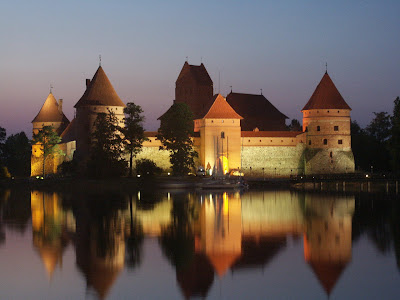Trakai Island Castle
(Lithuanian: Trakų salos pilis) is an island castle located in Trakai,
Lithuania on an island in Lake Galvė. The castle is sometimes referred to as
"Little Marienburg".
 |
| This is a file from wikimapia.org, Author: ArnoutSteenhoek |
According to the
chronicle legend, after a successful hunt, Grand Duke of Lithuania Gediminas found a great place near the town of Kernave
and decided to erect a castle on it and move the capital here. In the second
half of the 14th century, here in the Old Traki (Syaneyi Trakai), was standing
stone castle. Rules to them in 1337-1382 son of Gediminas Kęstutis. Around 1350
in the castle was born Vytautas. In 1375, Kęstutis moved his capital from Old
Traki to New Traki, which was protected by Lake Galvė. The construction of
Trakai Island Castle was related to the expansion and strengthening of the
Trakai Peninsula Castle. Castle in the Old Traki in 1391 was destroyed and never
rebuilt. In 1405, a plot of land with the remains of the old castle was given
to the Benedictine monks. The monastery stands on the old citadel.
The
castle was damaged during an attack by the Teutonic Knights in 1377. After the
assassination of Kęstutis, a power struggle between Jogaila and Vytautas the
Great for the title of Grand Duke of Lithuania began. The castle was besieged
by both sides and was severely damaged. Soon after the reconciliation between
Jogaila and Vytautas, the second phase of construction started. This phase is
regarded as the major development in the history of the castle. Apparently,
during the truce with the Teutonic Order, the construction works were
supervised by the Order's stonemason Radike.
|
Name: Trakai Castle
Location:
Island
Trakai
Region:
Lake Galvė
|
Island Castle was once
the main residence of the Grand Duke Vytautas.
At the beginning of the
15th century Trakai was granted Magdeburg rights. It was the decision of Grand
Duke Vytautas, and in 1441, the order was confirmed by the Grand Duke Casimir.
Cities that have such rights were required each year to pay tribute to the
prince, as well as to repair and protect the castle.
After the Battle of
Grunwald July 15, 1410 the castle lost its military significance, as the main
enemy of the Grand Duchy of Lithuania, the Teutonic Order, was defeated. At
that time the castle experienced its heyday. In Trakai were magnificent
receptions and parties. Many foreign guests and travelers described events held
in the castle. Trakai was also visited by the Emperor of Rome, the kings of
Poland and the Czech Republic, the ambassadors of Greece, Moscow, Tver and
Ryazan Dukes. In 1477, the castle was visited by Contarini, ambassador of
Venice.
In 1430, after the
death of Duke Vytautas, Trakai was captured by the Lithuanian prince
Svidrigailov. But soon he was driven away by Vytautas brother, Duke Sigismund.
Until 1535 Trakai Castle was considered the seat of the Lithuanian princes.
Here long enough were kept all documents from the office of the dukes (Lithuanian
Metrica).
 |
| This is a file from the www.allcastles.ru |
When between the city
of Kaunas and Vilnius was installed the direct way, Trakai was located away
from the main trade routes. Therefore, in the 16th century Trakai lost its
significance.
In 1616 the Duke of
Lithuania and King of Poland, Sigismund III issued a decree banning the
military units to enter the territory of the city and looting of local
residents. But despite of this fact, residents of Trakai regularly subjected to
robbery. In 1655, during the war between Russia and Lithuania, Trakai Castle
was abandoned and destroyed. By the end of 19th century castle was a ruin.
 |
| This is a file from the ww.panoramio.com, Author: Yustas |
During the 19th
century, castle reconstruction plans were prepared. Its original frescos were
preserved and copied by Wincenty Smokowski. The Imperial Archaeological
Commission initiated the documentation of the remaining castle in 1888. In 1905
the Imperial Russian authorities decided to partially restore the castle ruins.
During World War I, Germans brought in their specialists, who made several
attempts to restore the castle. In 1935-1941 parts of the Ducal Palace walls
were strengthened, and the southeastern forecastle tower was rebuilt, including
sections of its walls. Lithuanian and Polish preservationists worked on the
project, but the work stopped when the war gained in intensity. After World War
II, a major reconstruction project was begun in 1946; active work started in
1951-1952. The major portion of the reconstruction was finished in 1961. The
castle was reconstructed in a 15th century style.
Trakai Island Castle is
now a major tourist attraction of Lithuania. Since 1962 inside the castle is a museum of the history
of Trakai and souvenir shops.
In the preparation of this
article, were mainly used materials of websites: www.wikipedia.org and www.allcastles.ru.

очень красивый замок.. вот бы экскурсию по всем этим замкам!!! ммммммммм
ReplyDeleteБыл здесь несколько раз, замок не только очень красивый сам по себе, но и в очень красивом месте.
ReplyDeleteДа согласен замок очень красивый... полезная и интересная информация в статье, супер...
ReplyDeleteI had been there in the far 1997. Simply wonderful.
ReplyDeleteI find it fascinating how this castle seamlessly blends defensive features with opulent design.
ReplyDelete